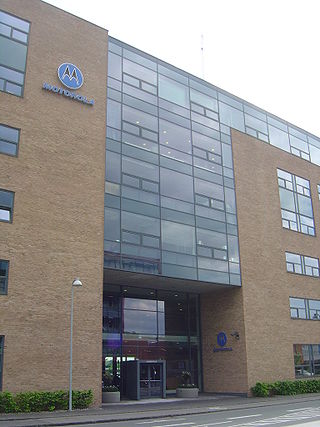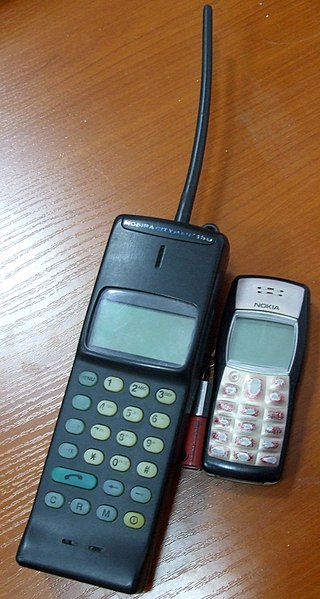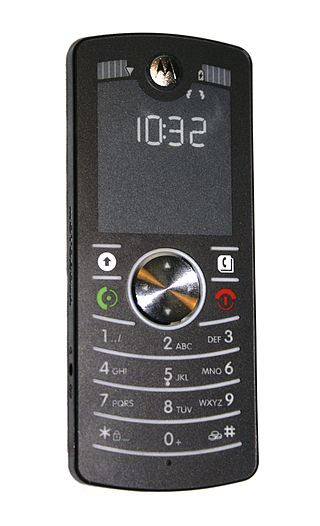
Advanced Mobile Phone System (AMPS) was an analog mobile phone system standard originally developed by Bell Labs and later modified in a cooperative effort between Bell Labs and Motorola. It was officially introduced in the Americas on October 13, 1983, and was deployed in many other countries too, including Israel in 1986, Australia in 1987, Singapore in 1988, and Pakistan in 1990. It was the primary analog mobile phone system in North America through the 1980s and into the 2000s. As of February 18, 2008, carriers in the United States were no longer required to support AMPS and companies such as AT&T and Verizon Communications have discontinued this service permanently. AMPS was discontinued in Australia in September 2000, in India by October 2004, in Israel by January 2010, and Brazil by 2010.

The Global System for Mobile Communications (GSM) is a standard developed by the European Telecommunications Standards Institute (ETSI) to describe the protocols for second-generation (2G) digital cellular networks used by mobile devices such as mobile phones and tablets. GSM is also a trade mark owned by the GSM Association. GSM may also refer to the Full Rate voice codec.

Motorola, Inc. was an American multinational telecommunications company based in Schaumburg, Illinois. It was founded in 1928 as Galvin Manufacturing Corporation by brothers Paul and Joseph Galvin. The company changed its name to Motorola in 1947. After having lost $4.3 billion from 2007 to 2009, Motorola was split into two independent public companies, Motorola Mobility and Motorola Solutions, on January 4, 2011. The reorganization was structured with Motorola Solutions legally succeeding Motorola, Inc., and Motorola Mobility being spun off.

Celcom Axiata Berhad is the oldest mobile telecommunications provider in Malaysia. Celcom is a member of the Axiata group of companies. Celcom was merged with Digi to form CelcomDigi on 1 December 2022.

NMT is an automatic cellular phone system specified by Nordic telecommunications administrations (PTTs) and opened for service on 1 October 1981. NMT is based on analogue technology and two variants exist: NMT-450 and NMT-900. The numbers indicate the frequency bands used. NMT-900 was introduced in 1986 and carries more channels than the older NMT-450 network.
GSM frequency bands or frequency ranges are the cellular frequencies designated by the ITU for the operation of GSM mobile phones and other mobile devices.
1G refers to the first generation of cellular network (wireless) technology. These are mobile telecommunications standards that were introduced in the 1980s and were superseded by 2G. The main difference between these two mobile cellular generations is that the audio transmissions of 1G networks were analog, while 2G networks were entirely digital.

The history of mobile phones covers mobile communication devices that connect wirelessly to the public switched telephone network.

The DynaTAC is a series of cellular telephones manufactured by Motorola from 1983 to 1994. The Motorola DynaTAC 8000X received approval from the U.S. FCC on September 21, 1983. A full charge took roughly 10 hours, and it offered 30 minutes of talk time. It also offered an LED display for dialing or recall of one of 30 phone numbers. It was priced at $3,995 in 1984, its commercial release year, equivalent to $11,716 in 2023. DynaTAC was an abbreviation of "Dynamic Adaptive Total Area Coverage".

A mobile phone feature is a capability, service, or application that a mobile phone offers to its users. Mobile phones are often referred to as feature phones, and offer basic telephony. Handsets with more advanced computing ability through the use of native code try to differentiate their own products by implementing additional functions to make them more attractive to consumers. This has led to great innovation in mobile phone development over the past 20 years.

The StarTAC is a series of mobile phones released by Motorola starting in 1996. It is the successor of the MicroTAC, a semi-clamshell design first launched in 1989. Whereas the MicroTAC's flip folded down from below the keypad, the StarTAC folded up from above the display. The StarTAC was among the first mobile phones to gain widespread consumer adoption; approximately 60 million StarTACs were sold.

Martin Cooper is an American engineer. He is a pioneer in the wireless communications industry, especially in radio spectrum management, with eleven patents in the field.
The Motorola E770 mobile phone is a 3G phone that operates primarily on the third generation phone network; however, it can be downscable to GPRS 2.5 and below if required.

The Motorola F3, frequently known as the Motofone, is a candybar style GSM mobile phone from Motorola, released on 28 November 2006. It was the first mobile phone to use an electronic paper display.
The Motorola Slvr is a former series of candybar mobile phones from Motorola, and was one of the series in the 4LTR line. The first phones were released in early 2005. Inspired by the Razr, they were designed to be very thin and lightweight.

The Motorola MicroTAC is a cellular phone first manufactured as an analog version in 1989. GSM-compatible and TDMA/Dual-Mode versions were introduced in 1994. The MicroTAC introduced a new "flip" design, where the "mouthpiece" folded over the keypad, although on later production the "mouthpiece" was actually located in the base of the phone, along with the ringer. This set the standard and became the model for modern flip phones today. Its predecessor was the much larger Motorola DynaTAC and it was succeeded by the Motorola StarTAC in 1996. "TAC" was an abbreviation of "Total Area Coverage" in all three models.

The Motorola bag phone is the colloquial name for a line of personal transportable cellular telephones manufactured by Motorola, inc. from 1988 to 2000.

The HTC Touch2, is a mobile telephone running the Windows Mobile operating system. The phone was designed and manufactured by HTC, and was released in Europe in November 2009. It is a middle budget smart phone featuring Windows Mobile 6.5 and Touch Flo 2D.
Cellular frequencies are the sets of frequency ranges within the ultra high frequency band that have been assigned for cellular-compatible mobile devices, such as mobile phones, to connect to cellular networks. Most mobile networks worldwide use portions of the radio frequency spectrum, allocated to the mobile service, for the transmission and reception of their signals. The particular bands may also be shared with other radiocommunication services, e.g. broadcasting service, and fixed service operation.














